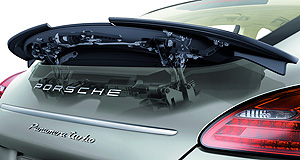Porsche Panamera floats on air
BY RON HAMMERTON | 19th Mar 2009

Revealing more technical insights into the four-door, four-seat sports ‘coupe’ ahead of its public reveal at April’s Shanghai motor show, Porsche today announced that five technical innovations would make their luxury-performance-car debut on Panamera.
These include the first automatic idle-stop function with a dual-clutch transmission, an air suspension system that can gain volume on demand, and active aerodynamics via a multi-stage adjustable rear spoiler on the flagship Panamera Turbo.
Porsche has also confirmed that Panamera will be powered exclusively by its direct-injection 294kW 4.8-litre V8 adapted from the Cayenne, dashing speculation that a six-cylinder entry-level model might be waiting in the wings – at least for now.
All three variants will get Porsche’s acclaimed PDK double-clutch transmission, which comes with fuel-saving idle-stop – a first in this league.
This function, plus widespread use of weight-saving materials, flat-floor aerodynamics and state-of-the-art direct injection, have all helped to drive the claimed fuel consumption down to 10.8L/100km for the naturally-aspirated Panamera S base model in the new European driving cycle test – comparable with its two-door, six-cylinder boxer-engined 911 siblings.

The Porsche release did not give fuel consumption figures for the heavier AWD Panamera Turbo, but if it pays a similar fuel consumption premium to the turbo 911 models, it will be in the 12-13L/100km range.
This, however, is still well inside the figures for most rivals in the luxury sports segment, and will appeal to buyers who care about footprint as much as performance.
The Panamera weighs in a 1770kg – about 80kg heavier than the beefiest 911, the Turbo Cabriolet.
This extra bulk is evident in the 5.4 second 0-100km/h sprint – about half a second slower than most 911s - but it could have been worse.
Porsche pulled out all stops to lighten the body, with hi-tech solutions in both materials and construction methods. The doors, for example, have a skeleton of pressure-cast aluminium and a magnesium window frame, wrapped in an aluminium skin.
Aerodynamics are aided by what Porsche describes as a completely flat underfloor, to cut drag at highway speeds.
A more obvious addition is the adjustable rear spoiler, which – unlike previous Porsche pop-up rear wings – rises in increments as required. Called an adaptive-motion rear spoiler, the wing is only available on the Panamera Turbo.
The Turbo also comes standard with the new adaptive air suspension, which is optional on the other two models, the S and 4S.
While air suspension systems have been around forever – including on the current Porsche Cayenne – the Panamera system is unique in that it can gain volume as well as pressure, opening up a wide variety of ride, comfort and sports handling options.
The Panamera Turbo also gets Porsche Dynamic Chassis Control (PDCC) and a limited-slip differential – two features that are also extra cost options on the S and 4S.
And if that is not enough, Panamera AWD buyers can tick the box for the Sports Plus button that fires up the optional Sports Chrono Package, which sharpens the drivetrain and handling functions for an “uncompromising high-performance set-up”.
The aim, according to Porsche, is to deliver a car with limousine-like silkiness and sports performance worthy of the Porsche name.
Porsche has chosen Shanghai for the April 20 launch of the Panamera, which goes on sale in Australia in October with prices ranging from $270,200 for the S to $364,900 Panamera Turbo.